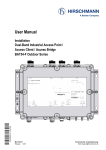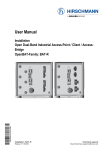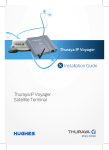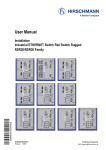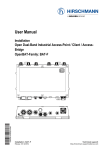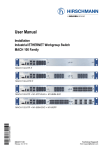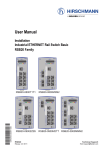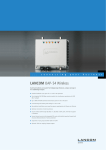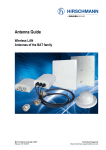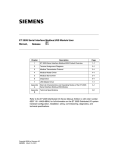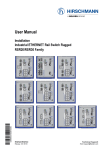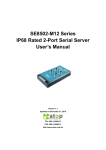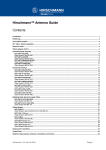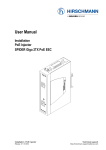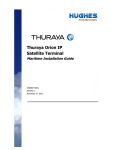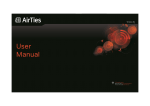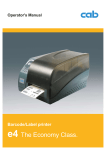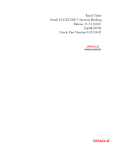Download User Manual - e-catalog
Transcript
User Manual Installation Dual-Band Industrial Access Point / Client / Access Bridge BAT Family AUX 1 Main 2 Main 1 Main AUX 2 AUX BAT54-F Uin : 24 VDC Uin : 48 VDC IP67 WLAN Access Point 2 3 1 4 V.24 1 2 3 4 Pin TX RX N.C. GND Function 2 3 1 4 Ethernet Reset 1 2 3 4 Pin TD+ RD+ TDRDFunction 2 1 3 4 5 1 2 3 4 5 Pin BAT54-F Single CLASS 2 Iin : 400 mA CLASS 2 Iin : 170 mA (PoE) +24V DC 0V 0V +24V DC N.C. Function P LS/DA WLAN 1 Power Uin : 24 VDC Uin : 48 VDC IP67 WLAN Access Point WLAN 2 2 3 1 4 V.24 LED BAT54-F 1 2 3 4 Pin TX RX N.C. GND Function Reset 2 3 1 4 1 2 3 4 Pin TD+ RD+ TDRDFunction 2 3 1 4 1 2 3 4 Pin Main 3 4 V.24 1 2 3 4 Pin Uin : 24 VDC Uin : 48 VDC TX RX N.C. GND Function 2 3 1 4 Ethernet Reset LED Antenna 2 Antenna 1 AUX Antenna 3 BAT300-F BAT54-F Client 2 LS/DA 2 P WLAN LS/DA 1 BAT54-F Single IP67 WLAN Access Point 1 TD+ RD+ TDRDFunction Ethernet 1 Ethernet 2 CLASS 2 Iin : 420 mA CLASS 2 Iin : 170 mA (PoE) 1 2 3 4 Pin TD+ RD+ TDRDFunction 2 1 3 4 5 1 2 3 4 5 Pin +24V DC 0V 0V +24V DC N.C. Function Power CLASS 2 Iin : 420 mA CLASS 2 Iin : 170 mA (PoE) P LS/DA WLAN Uin : 24 VDC Uin : 48 VDC IP67 WLAN Access Point NC 2 3 1 4 V.24 LED BAT54-F Client 1 2 3 4 Pin TX RX N.C. GND Function Reset 2 3 1 4 Ethernet 1 2 3 4 Pin TD+ RD+ TDRDFunction 2 1 3 4 5 Power 1 2 3 4 5 Pin +24V DC 0V 0V +24V DC N.C. Function CLASS 2 Iin : 420 mA CLASS 2 Iin : 170 mA (PoE) P LS/DA WLAN NC LED BAT300-F Main Aux Main Aux ETH M1 WLAN1 WLAN2 P +24V 0V +24V 0V BAT54-Rail WLAN x BAT54-Rail Single BAT54-Rail Client BAT300-Ra Reset 12V DC Aux1 BAT54-Rail BAT Family Release 03 08/10 V.24 Aux2 BAT54-Rail Single BAT54-Rail Client BAT300-Rail Technical Support [email protected] The naming of copyrighted trademarks in this manual, even when not specially indicated, should not be taken to mean that these names may be considered as free in the sense of the trademark and tradename protection law and hence that they may be freely used by anyone. © 2010 Hirschmann Automation and Control GmbH Manuals and software are protected by copyright. All rights reserved. The copying, reproduction, translation, conversion into any electronic medium or machine scannable form is not permitted, either in whole or in part. An exception is the preparation of a backup copy of the software for your own use. For devices with embedded software, the end-user license agreement on the enclosed CD applies. The performance features described here are binding only if they have been expressly agreed when the contract was made. This document was produced by Hirschmann Automation and Control GmbH according to the best of the company's knowledge. Hirschmann reserves the right to change the contents of this document without prior notice. Hirschmann can give no guarantee in respect of the correctness or accuracy of the information in this document. Hirschmann can accept no responsibility for damages, resulting from the use of the network components or the associated operating software. In addition, we refer to the conditions of use specified in the license contract. You can get the latest version of this manual on the Internet at the Hirschmann product site (www.beldensolutions.com). Printed in Germany Hirschmann Automation and Control GmbH Stuttgarter Str. 45-51 72654 Neckartenzlingen Germany Tel.: +49 1805 141538 039 726-002-03-0810 – 6.9.10 Contents Safety instructions 5 About this manual 13 1 Device description 14 1.1 Properties and functions 1.1.1 BAT-F types 1.1.2 BAT-Rail types 1.1.3 BAT54 types 1.1.4 BAT300 types 1.1.5 BAT-BG/BGN types 1.1.6 Other features 14 15 15 15 16 16 16 1.2 Interfaces and control elements 1.2.1 BAT54-F 1.2.2 BAT54-F Single 1.2.3 BAT54-F Client 1.2.4 BAT300-F 1.2.5 BAT54-Rail 1.2.6 BAT54-Rail Single 1.2.7 BAT54-Rail Client 1.2.8 BAT300-Rail 19 19 20 21 22 23 24 25 26 1.3 Device models 1.3.1 BAT54-F devices 1.3.2 BAT54-Rail devices 1.3.3 BAT300-F devices 1.3.4 BAT300-Rail devices 1.3.5 BAT-BG/BGN devices 27 27 28 28 28 29 2 Assembly and start-up 30 2.1 Installing the device 30 2.2 Unpacking and checking 30 2.3 Putting components together (BAT-F) 31 2.4 Selecting the location for mounting/ setting up 31 2.5 Mounting outdoors (BAT-F) 2.5.1 Lightning protection 2.5.2 Pole mounting 31 31 33 2.6 DIN rail mounting (BAT-Rail) 33 2.7 Flat surface mounting 2.7.1 BAT-F 34 34 BAT Family Release 03 08/10 3 2.7.2 BAT-Rail 35 2.8 Mounting/connecting external antennas 2.8.1 Connections for external antennas on BAT-F 2.8.2 Connections for external antennas on BAT-Rail 2.8.3 Mounting external antennas 35 35 38 40 2.9 Connecting LAN and WLAN connectors 2.9.1 BAT-F 2.9.2 BAT-Rail 40 40 40 2.10 Grounding 2.10.1 BAT-F 2.10.2 BAT-Rail 41 41 41 2.11 Connecting the supply voltage 2.11.1 5-pin M12 connector (BAT-F) 2.11.2 4-pin terminal block (BAT-Rail) 2.11.3 Power over Ethernet (PoE) power supply via the LAN cable 42 42 42 43 2.12 Connecting the data lines 2.12.1 10/100 Mbit/s twisted pair connection 2.12.2 10/100 Mbit/s twisted pair connection 44 44 45 2.13 Installing the BAT-F X2 housing cover 46 2.14 Startup procedure 2.14.1 BAT-F 2.14.2 BAT-Rail 47 47 47 2.15 Configuring devices 48 2.16 Installing external antennas 48 2.17 Display elements 50 2.18 Operation element (reset button) 2.18.1 Functions 2.18.2 BAT-F 2.18.3 BAT-Rail 53 53 53 54 2.19 Basic set-up 54 2.20 Disassembly 56 3 Technical data 57 A Further Support 64 4 BAT Family Release 03 08/10 Safety instructions Notes on safety This manual contains instructions to be observed for ensuring your personal safety and for preventing damage. The warnings appear next to a warning triangle with a different heading depending on the degree of danger posed: Danger! Means that death, serious physical injury or significant damage to property will occur if the corresponding safety measures are not carried out. Warning! Means that death, serious physical injury or significant damage to property could occur if the corresponding safety measures are not carried out. Caution! Means that minor physical injury or damage to property can occur if the required safety measures are not carried out. Note: Contains important information on the product, on how to manage the product, or on the respective section of the documentation to which your special attention is being drawn. Certified usage The device may only be employed for the purposes described in the catalog and technical description, and only in conjunction with external devices and components recommended or approved by the manufacturer. The product can only be operated correctly and safely if it is transported, stored, installed and assembled properly and correctly. Furthermore, it must be operated and serviced carefully. Supply voltage The devices are designed for operation with extra-low voltage (SELV). Accordingly, SELV circuits with voltage restrictions in accordance with IEC/EN 60950-1 may be connected to the supply voltage connectors. The supply voltage is electrically isolated from the housing. Use undamaged parts. For BAT300-Rail: Make sure that the DC power supply line has a maximum length of 3 meters. BAT Family Release 03 08/10 5 Relevant for North America: For use in Class 2 circuits. Only use copper wire/conductors of class 1, 75 °C or 90 °C (167 °F or 194 °F). Relevant for North America: For use in Class 2 circuits. The device may only be connected to a supply voltage of class 2 that fulfills the requirements of the National Electrical Code, Table 11(b). If the voltage is being supplied redundantly (two different voltage sources), the combined supply voltages must fulfill the requirements of the National Electrical Code, Table 11(b). Relevant for North America: Adapters for BAT-F types providing field wiring means you obtain from the manufacturer. For field wiring, use a type E12AAA5A1A power supply cable, manufacured by Belden. Shielding ground The shield of the connectable twisted pair cables is connected to the metal casing of the device as a conductor. Beware of possible short circuits when connecting a cable section with conductive shielding braiding. Housing Only technicians authorized by the manufacturer are permitted to open the housing. Make sure that the electrical installation meets local or nationally applicable safety regulations. Warning! Never insert sharp objects (small screwdrivers, wires, etc.) into the inside of the product. There is the risk of an electric shock. BAT-F types: A separate screw connector on the housing is provided for the functional ground (FE). This is indicated by the functional ground symbol ( ). The functional ground is electrically connected to the switching ground and the metal housing of the device. BAT-Rail types: The lower panel of the device housing is grounded by means of the DIN rail. If installed in a living area or office environment, the device must be operated exclusively in switch cabinets with fire protection characteristics according to EN 60950-1. 6 BAT Family Release 03 08/10 Environment The device may only be operated at the specified surrounding air temperature (temperature of the ambient air at a distance of up to 5 cm (1.97 in) from the device) and relative air humidity specified in the technical data. Install the device in a location where the climatic threshold values specified in the technical data will be observed. Important: Relevant for BAT-F types: Environmental Rating: Type 1 - indoor use only. For use in NFPA 79 applications only. When installing external antennas, adhere to the regulations of the country in which you are operating the WLAN device. In ambient temperatures under -10 °C, use cabling designed for minimum temperatures. Relevant for use in Ex zone 2 according to ATEX 95 (ATEX 100a): Only products labeled accordingly may be operated in Ex zone 2. When operating the BAT-300F X2 types in Ex zone 2, the following applies: II 3G Ex nA II T4 -20 °C ... +55 °C KEMA 10 ATEX 0124 X Temperature Code T4 List of Standards Ambient -20 °C … +55 °C EN 60079-0: 2006 EN 60079-15: 2005 CLC/TR 50427: Dez. 2004 When operating the BAT-54F X2 types in Ex zone 2, the following applies: II 3G Ex nA II T4 -20 °C ... +60 °C KEMA 07 ATEX 0124 X Temperature Code T4 List of Standards Ambient -20 °C … +60 °C EN 60079-0: 2006 EN 60079-15: 2005 CLC/TR 50427: Dez. 2004 DO NOT OPEN THE DEVICE WHEN IT IS ELECTRICALLY CHARGED. DO NOT DETACH ANY CONNECTORS WHEN THE DEVICE IS ELECTRICALLY CHARGED. DO NOT REMOVE THE LABELED HOUSING COVER. BAT Family Release 03 08/10 7 The BAT-F X2 (FCC) types are installed with a housing cover - as mounted in the state on delivery. Special conditions for safe use Provisions shall be made to prevent the rated voltage from being exceeded by transient disturbances of more than 40 %. When the temperature under rated conditions exceeds 70 °C at the cable or conduit entry point, or 80 °C at the branching point of the conductors, the temperature specification of the selected cable shall be in compliance with the actual measured temperature values. Lightning protection When you mount devices and / or antennas outdoors, there is a risk of them being struck by lightning. Additionally, there is the risk of voltage surges being transmitted into the interior of the building. It is your responsibility to take appropriate measures to mitigate the effects of lightning strikes. Make sure the equipment is installed by a licensed electrician in accordance with local, regional and national regulations for codes and standards (such as VDE 0182 and IEC 62305) and according to best practices for your application and environment. Warning When you mount devices outside buildings, there is a risk of them being struck by lightning. Additionally, there is the danger of voltage strikes being transmitted into the interior of the building. See the information in the “WLAN Outdoor Guide”, chapter “Lightning and Surge Voltage Protection”. Make sure that your plant designer or installer has carried out suitable lightning prevention measures. Qualification requirements for personnel Qualified personnel as understood in this manual and the warning signs, are persons who are familiar with the setup, assembly, startup, and operation of this product and are appropriately qualified for their job. This includes, for example, those persons who have been: X trained or directed or authorized to switch on and off, to ground and to label power circuits and devices or systems in accordance with current safety engineering standards; 8 BAT Family Release 03 08/10 X trained or directed in the care and use of appropriate safety equipment in accordance with the current standards of safety engineering; X trained in providing first aid. General safety instructions Electricity is used to operate this equipment. Comply with every detail of the safety requirements specified in the operating instructions regarding the voltages to apply (see page 5). Non-observance of these safety instructions can therefore cause material damage and/or serious injuries. Only appropriately qualified personnel should work on this device or in its vicinity. These personnel must be thoroughly familiar with all the warnings and maintenance procedures in accordance with this operating manual. The proper and safe operation of this device depends on proper handling during transport, proper storage and assembly, and conscientious operation and maintenance procedures. Never start operation with damaged components. Only use the devices in accordance with this manual. In particular, observe all warnings and safety-related information. Any work that may be required on the electrical installation may only be carried out by personnel trained for this purpose. National and international safety regulations Make sure that the electrical installation meets local or nationally applicable safety regulations. When installing external antennas, adhere to the regulations of the country in which you are operating the WLAN device. CE marking The devices comply with the regulations contained in the following European directive: 1999/5/EC Directive of the European Parliament and the council for radio installations and telecommunication systems and for the mutual recognition of their conformity. BAT Family Release 03 08/10 9 This directive also contains the goals of directive 2004/108/EC of the European Parliament and the council for standardizing the regulations of member states relating to electromagnetic compatibility, and directive 2006/95/EC of the European Parliament and the council for standardizing the regulations of member states relating to electrical equipment to be used within specific voltage ranges, but without applying the lower voltage threshold. This product may be operated in all EU states (EU = European Union) under the condition that it has been configured correctly. In accordance with the above-named EC directive (EC = European Community), the EC conformity declaration will be at the disposal of the relevant authorities at the following address: Hirschmann Automation and Control GmbH Stuttgarter Str. 45-51 72654 Neckartenzlingen Tel.: +49 1805 141538 This product can be used in living areas (living area, place of business, small business) and in industrial areas. Information on using devices in motor vehicles (e1) Some variants of the devices are e1-certified. Only operate suitably labeled products in motor vehicles. Note: To meet the requirements of directive 1999/5/EG (R&TTE directive) when operating the device in a motor vehicle, do one of the following: X Supply the power to the device via a Power over Ethernet (PoE) Switch or via a power unit that conforms to IEEE 802.3af. You will find information on PoE-compatible Switches from Hirschmann at www.beldensolutions.com X Install an upstream filter on the 24V DC power supply. You will find information on suitable filters at www.beldensolutions.com. Note: If you are using an e1-certified device in a vehicle and want to be able to drive the vehicle freely within the EU, set the country profile for Germany. This country profile is identical to all the country profiles for EU countries. Do not, however, use any special frequencies, such as BFWA. 10 BAT Family Release 03 08/10 FCC note: This device complies with part 15 of the FCC rules. Operation is subject to the following two conditions: X This device may not cause harmful interference, and X This device must accept any interference received, including interference that may cause undesired operation. Note: This equipment has been tested and found to comply with the limits for a Class B digital device, pursuant to part 15 of the FCC Rules. These limits are designed to provide reasonable protection against harmful interference in a residential installation. This equipment generates, uses and can radiate radio frequency energy and, if not installed and used in accordance with the instructions, may cause harmful interference to radio communications. However, there is no guarantee that interference will not occur in a particular installation. If this equipment does cause harmful interference to radio or television reception, which can be determined by turning the equipment off and on, the user is encouraged to try to correct the interference by one or more of the following measures: Reorient or relocate the receiving antenna. Increase the separation between the equipment and receiver. Connect the equipment into an outlet on a circuit different from that to which the receiver is connected. Consult the dealer or an experienced radio/TV technician for help. Important note: This equipment complies with FCC and IC RSS-102 radiation exposure limits set forth for an uncontrolled environment. This equipment should be installed and operated with minimum distance 40 cm (15.8 in, applied to a 23 dBi antenna) between the radiator and your body. The antenna used for this transmitter must not be co-located with any other transmitters within a host device, except in accordance with FCC multi-transmitter product procedures. This transmitter is restricted to indoor use only within the 5.15-5.25 GHz band to reduce potential for harmful interference to co-channel mobile satellite systems. This Class B digital apparatus complies with Canadian ICES-003. Cet appareil numérique de la classe B est conforme à la norme NMB-003 du Canada. BAT Family Release 03 08/10 11 To reduce potential radio interference to other users, the antenna type and its gain should be so chosen that the equivalent isotropically radiated power (e.i.r.p.) is not more than that permitted for successful communication. This device has been designed to operate with the antennas listed below in point-to-multipoint systems, and having a maximum gain of 9 dBi: Device model BAT54-… (FCC) Antennas operating with this device model BAT-ANT-N-5A-IP65 BAT-ANT-N-6G-IP65 BAT-ANT-N-6ABG-IP65 BAT-ANT-N-8G-DS-IP65 BAT-ANT-N-9A-DS-IP65 BAT-ANT-N-LC-G-50m-IP65 BAT-ANT-N-LC-G-100m-IP65 BAT300-… (FCC) BAT-ANT-N-8G-DS-IP65, BAT-ANT-N-9A-DS-IP65, BAT-ANT-N-MiMoDB-5N-IP65, BAT-ANT-N-MiMo5-9N-IP65 Table 1: Antennas for use in point-to-multipoint systems The antennas listed below have been designed for use exclusively in fixed point-to-point systems operating in the 2400-2483 MHz and the 57255850 MHz band and having a maximum gain of 23 dBi: Device model Antennas operating with this device model BAT54-… (FCC) BAT-ANT-N-14G-IP23 BAT300-… (FCC) BAT-ANT-N-23A-VH-IP65 Table 2: Antennas for use in fixed point-to-point systems Antennas not included in this list are strictly prohibited for use with this device. The required antenna impedance is 50 ohms. Recycling note After usage, this product must be disposed of properly as electronic waste, in accordance with the current disposal regulations of your county, state and country. 12 BAT Family Release 03 08/10 About this manual The following manuals are available as PDF files on the CD-ROM supplied: X "Installation" user manual X Reference Manual Legend The symbols used in this manual have the following meanings: X Listing Work step Subheading BAT Family Release 03 08/10 13 1 1.1 Device description Properties and functions The devices of the BAT family enable you to set up WLANs (Wireless Local Area Networks) in order to connect individual devices (PCs and mobile computers) with a local network. In contrast to a conventional network connection via copper cables and glass fibers, some of the communication is by means of a radio link. The devices of the BAT family can be used for both new installations and for expanding an existing LAN. Thanks to their high level of flexibility, you can combine large, small, mobile and non-mobile locations. Anywhere that high bandwidths, stable operation and network security are required, wireless LAN with the devices of the BAT family provides the ideal solution. The BAT54-F is an access point/client with a WLAN interface for dualband operation in accordance with IEEE 802.11b/g and IEEE 802.11a/h, and it is specially designed for outdoor use with protection class IP67. The BAT54-F can be installed quickly and easily using wizards via the Windows configuration software or the Web interface. The wide range of BAT antennas provide the correct solution for every requirement - even out-of-thebox solutions. The devices are designed for the special requirements of industrial automation. They are suitable for outdoor use and in environments with the danger of explosions. They meet the relevant industry standards, provide very high operational reliability, even under extreme conditions, and also long-term reliability and flexibility. The devices operate without fans and have a redundant voltage supply. You can mount the devices on a pole or on a flat surface (e.g. wall). The devices differ with regard to their design, the standards they support and their certifications, as shown in the table below: 14 BAT Family Release 03 08/10 802.11 a/b/g/h/i/n 801.11 a/b/g/h/i BAT300 types BAT54 types Radio standards Design Indoor BAT-Rail types Outdoor BAT-F types BAT54-Rail BAT54-Rail-Client BAT54-Rail Single BAT54-F BAT54-F Single BAT54-F Client Ex range BAT X2 types BAT54-F X2 BAT54-F Single X2 BAT54-F Client X2 BAT300-Rail BAT300-F BAT300-F X2 Table 3: Range of applications for BAT device types 1.1.1 BAT-F types The BAT-F devices have protection class IP67. The devices are particularly suitable for field use. You can mount the devices on a pole or on a flat surface (e.g. wall). BAT-X2 types BAT-X2 devices are suitable for use in environments with the danger of explosions (Ex zone 2 areas according to ATEX 95 / ATEX 100a). 1.1.2 BAT-Rail types BAT-Rail devices are suitable for use on DIN rails and on machines in the production area, as well as on vehicles. You can snap them quickly and simply onto the DIN rail or mount them on a flat surface (e.g. wall). With 5way redundant voltage supply (4-way for the BAT-Client) and a vibrationresistant metal housing, the devices provide high operational reliability. 1.1.3 BAT54 types The BAT54 is a dual-band industrial wireless LAN access point/client with two independent WLAN modules in accordance with IEEE 802.11a/b/g/h and IEEE 802.11i. In particular, the devices support the security mechanisms, authentication procedures and data encryptions defined in the IEEE 802.11i standard. BAT Family Release 03 08/10 15 1.1.4 BAT300 types The BAT300 is a dual-band industrial high-performance wireless LAN access point/client in accordance with IEEE 802.11a/b/g/h and 802.11n. The devices provide a higher radio output with a bandwidth of up to 300 Mbit/s. They support MIMO (Multiple Input Multiple Output) and Multipath. The bandwidth is increased by using the multipath transmission by means of reflections. Three antennas for sending and receiving ensure more stable network coverage with fewer shadow areas (see following figure). BAT300-Rail Figure 1: Schematic representation of MIMO (Multiple Input Multiple Output) 1.1.5 BAT-BG/BGN types BAT-BG/BGN devices only support the use of the 2.4 GHz ISM wave band. Note: Note that the function descriptions for the BAT-BG/BGN devices in this installation guide and in the user manuals for the devices only apply to operation with 2.4 GHz. Hirschmann supports you by providing country profiles. These profiles help you to conform to the requirements of the country in which you are operating the WLAN installation. Make sure you always set the correct country profile. 1.1.6 Other features Features can be managed via a Web browser, via Telnet, with a management software product (such as ConneXview or LANconfig/ LANmonitor) or locally on the device (V.24 interface). The devices provide high mobility combined with maximum security. The devices provide you with a large range of features: X Sturdy metal housing with protection class IP67 (BAT-F) or protection class IP40 (BAT-Rail) 16 BAT Family Release 03 08/10 X Secure mounting on a flat surface (e.g. wall), a pole (BAT-F) or a DIN rail (BAT-Rail) X Redundant power supply with two 24 V supplies, Power over Ethernet, and one 12 V supply X Temperature range –30 °C to +55 °C X Wireless LAN interfaces in accordance with IEEE 802.11b/g and IEEE 802.11a/h or IEEE 802.11n X Creation of redundant WLAN connections for secure data transmission X Maximum security, also for point-to-point with encryption in accordance with the IEEE 802.11i standard X RS-232 serial interface for configuration, remote access and the provision of a serial gateway X Radio modules can be operated separately as an access point or client (apart from BAT-Client types) X Fast and reliable roaming and prioritizing, also with IEEE 802.1x authentication X High performance operating system with a wide range of functions via MultiSSID, VLAN, Rapid Spanning Tree, RADIUS server, IP router, firewall, DHCP server, etc. X Management software for Windows, Web configuration, Telnet interface and management via SNMP Antenna technology for a high quality signal X For operation indoors and outdoors X Mounting with cables provided X Secure wall and pole bracket X Optimized distribution and performance for every application X Long transmission distances X Designed for 2.4 GHz and 5 GHz wave bands Cross-platform WLAN management X A standardized, cross-platform management system for transparent and efficient network monitoring (SNMP) X Windows management suite: LANconfig, LANmonitor, WLANmonitor X Direct management via Web browser (HTTP, HTTPS) X Command line level: TelNet X Can always be reached via serial interface X Complete and partial configuration of multiple devices via scripting X WLANmonitor for convenient monitoring of WLANs with Rogue AP Detection X Monitoring of all BAT family devices as clients and as access points in an application BAT Family Release 03 08/10 17 Communication via all levels The addition, to the BAT wireless transmission system, of the RS20/ RS30/RS40 open rail range of switches, the MICE range of switches, the MACH range of backbone switches, and the EAGLE security system, provides continuous communication across all levels of the company. 18 BAT Family Release 03 08/10 1.2 Interfaces and control elements 1.2.1 BAT54-F The device is equipped with the following connectors and operation elements: 9 8 7 AUX 1 Main 2 Main 1 6 AUX 2 BAT54-F Uin : 24 VDC Uin : 48 VDC IP67 WLAN Access Point 2 1 V.24 1 2 3 4 4 Pin 3 TX RX N.C. GND Function Reset 2 1 1 2 3 4 4 Pin 3 Ethernet TD+ RD+ TDRDFunction 2 1 3 4 5 1 2 3 4 5 Pin Power +24V DC 0V 0V +24V DC N.C. Function CLASS 2 Iin : 400 mA CLASS 2 Iin : 170 mA (PoE) P LS/DA WLAN 1 WLAN 2 Power LS/DA LED WLAN 1 1 2 3 4 5 WLAN 2 5 Interfaces and display and control elements 1 V.24 Serial interface, 4-pin M12 socket with A coding, data rate min. 19.2 kbit/s, max. 115 kbit/s, connector for serial configuration cable 2 Reset Reset button behind a removable IP67 cap restarts the device or resets the configuration 3 Ethernet Ethernet port: 4-pin M12 socket with D coding, 10/100BASE-TX, Autosensing, Power over Ethernet (PoE), automatic MDI/MDIX recognition (no crossover cable required) 4 Power Power supply connector for safety extra-low voltage (SELV/PELV), 5-pin M12 plug 5 LED 4 display elements (power, LS/DA, WLAN1, WLAN2) 6 AUX 2 Auxiliary connector for the second WLAN module for connecting external antennas 7 AUX 1 Auxiliary connector for the first WLAN module for connecting external antennas 8 Main 2 Main connector for the second WLAN module for connecting external antennas 9 Main 1 Main connector for the first WLAN module for connecting external antennas BAT Family Release 03 08/10 19 1.2.2 BAT54-F Single The device is equipped with the following connectors and operation elements: 7 6 Main AUX BAT54-F Single Uin : 24 VDC Uin : 48 VDC IP67 WLAN Access Point 2 1 V.24 1 2 3 4 4 Pin 3 TX RX N.C. GND Function Reset 2 1 1 2 3 4 4 Pin 3 Ethernet 2 TD+ RD+ TDRDFunction 2 3 1 4 1 2 3 4 Pin Ethernet 1 TD+ RD+ TDRDFunction CLASS 2 Iin : 420 mA CLASS 2 Iin : 170 mA (PoE) P LS/DA 2 WLAN LS/DA 1 Power LS/DA 2 LED WLAN LS/DA 1 1 2 3 4 5 5 Interfaces and display and control elements 1 V.24 Serial interface, 4-pin M12 socket with A coding, data rate min. 19.2 kbit/s, max. 115 kbit/s, connector for serial configuration cable 2 Reset Reset button behind a removable IP67 cap restarts the device or resets the configuration 3 Ethernet Second Ethernet port 2 4-pin M12 socket with D coding, 10/100BASE-TX, Autosensing, Power over Ethernet (PoE), automatic MDI/MDIX recognition (no crossover cable required) 4 Ethernet First Ethernet port 1 4-pin M12 socket with D coding, 10/100BASE-TX, Autosensing, Power over Ethernet (PoE), automatic MDI/MDIX recognition (no crossover cable required) 5 LED 4 display elements (power, LS/DA1, LS/DA2, WLAN) 6 AUX Auxiliary connector for the WLAN module for connecting external antennas 7 Main Main connector for the WLAN module for connecting external antennas 20 BAT Family Release 03 08/10 1.2.3 BAT54-F Client The device is equipped with the following connectors and operation elements: 7 6 Main AUX BAT54-F Client Uin : 24 VDC Uin : 48 VDC IP67 WLAN Access Point 2 1 V.24 1 2 3 4 4 Pin 3 TX RX N.C. GND Function Reset 2 1 1 2 3 4 4 Pin 3 Ethernet TD+ RD+ TDRDFunction 2 1 3 4 5 1 2 3 4 5 Pin Power +24V DC 0V 0V +24V DC N.C. Function CLASS 2 Iin : 420 mA CLASS 2 Iin : 170 mA (PoE) P LS/DA NC WLAN Power LS/DA LED WLAN 1 2 3 4 5 NC 5 Interfaces and display and control elements 1 V.24 Serial interface, 4-pin M12 socket with A coding, data rate min. 19.2 kbit/s, max. 115 kbit/s, connector for serial configuration cable 2 Reset Reset button behind a removable IP67 cap restarts the device or resets the configuration 3 Ethernet Ethernet port: 4-pin M12 socket with D coding, 10/100BASE-TX, Autosensing, Power over Ethernet (PoE), automatic MDI/MDIX recognition (no crossover cable required) 4 Power Power supply connector for safety extra-low voltage (SELV/PELV), 5-pin M12 plug 5 LED 4 display elements (power, LS/DA, WLAN, NC) 6 AUX Auxiliary connector for the WLAN module for connecting external antennas 7 Main Main connector for the WLAN module for connecting external antennas BAT Family Release 03 08/10 21 1.2.4 BAT300-F The device is equipped with the following connectors and operation elements: 8 7 6 Antenna 2 Antenna 1 Antenna 3 BAT300-F Uin : 24 VDC Uin : 48 VDC IP67 WLAN Access Point 2 1 V.24 1 2 3 4 4 Pin 3 TX RX N.C. GND Function Reset 2 1 1 2 3 4 4 Pin 3 Ethernet TD+ RD+ TDRDFunction 2 1 3 4 5 1 2 3 4 5 Pin Power +24V DC 0V 0V +24V DC N.C. Function CLASS 2 Iin : 420 mA CLASS 2 Iin : 170 mA (PoE) P LS/DA NC WLAN Power LS/DA LED NC 1 2 3 4 5 WLAN 5 Interfaces and display and control elements 1 V.24 Serial interface, 4-pin M12 socket with A coding, data rate min. 19.2 kbit/s, max. 115 kbit/s, connector for serial configuration cable 2 Reset Reset button behind a removable IP67 cap restarts the device or resets the configuration 3 Ethernet Ethernet port: 4-pin M12 socket with D coding, 10/100BASE-TX, Autosensing, Power over Ethernet (PoE), automatic MDI/MDIX recognition (no crossover cable required) 4 Power Power supply connector for safety extra-low voltage (SELV/PELV), 5-pin M12 plug 5 LED 4 display elements (power, LS/DA, WLAN, NC) 6 Antenna Main connector for the WLAN module for connecting the third external 3 antenna 7 Antenna Main connector for the WLAN module for connecting the second external 2 antenna 8 Antenna Main connector for the WLAN module for connecting the first external 1 antenna 22 BAT Family Release 03 08/10 1.2.5 BAT54-Rail The device is equipped with the following connectors and operation elements: 10 11 Main 1 Main 2 9 1 M1 WLAN1 8 WLAN2 2 BAT54-Rail 7 6 3 4 Aux1 Aux2 5 Interfaces and display and control elements 1 ETH1 First Ethernet port 10/100BASE-TX, Autosensing, Power over Ethernet (PoE), automatic MDI/ MDIX recognition (no crossover cable required) 2 +24V Power, power supply connector for safety extra-low voltage (SELV/PELV) 0V 3 12V DC Power, power supply connector for safety extra-low voltage (SELV/PELV) 4 AUX 1 Auxiliary connector for the first WLAN module for connecting external antennas 5 AUX 2 Auxiliary connector for the second WLAN module for connecting external antennas 6 V.24 MiniDin serial interface, data rate min. 19.2 kbit/s, max. 115 kbit/s, connector for serial configuration cable 7 Reset Reset button to restart device or reset the configuration 8 LED 4 display elements (power, M1, WLAN1, WLAN2) 9 ETH2 Second Ethernet port 10/100BASE-TX, Autosensing, Power over Ethernet (PoE), automatic MDI/ MDIX recognition (no crossover cable required) 10 Main 2 Main connector for the second WLAN module for connecting external antennas 11 Main 1 Main connector for the first WLAN module for connecting external antennas BAT Family Release 03 08/10 23 1.2.6 BAT54-Rail Single The device is equipped with the following connectors and operation elements: 7 8 Main 1 Aux ETH P 2 +24V 0V +24V 0V WLAN 6 x BAT54-Rail Single 5 Reset 12V DC V.24 4 3 Interfaces and display and control elements 1 ETH Ethernet port: 10/100BASE-TX, Autosensing, Power over Ethernet (PoE), automatic MDI/ MDIX recognition (no crossover cable required) 2 +24V Power, power supply connector for safety extra-low voltage (SELV/PELV) 0V 3 12V DC Power, power supply connector for safety extra-low voltage (SELV/PELV) 4 V.24 MiniDin serial interface, data rate min. 19.2 kbit/s, max. 115 kbit/s, connector for serial configuration cable 5 Reset Reset button to restart device or reset the configuration 6 LED 2 display elements (power, WLAN) 7 AUX Auxiliary connector for the WLAN module for connecting external antennas 8 Main Main connector for the WLAN module for connecting external antennas 24 BAT Family Release 03 08/10 1.2.7 BAT54-Rail Client The device is equipped with the following connectors and operation elements: 7 8 Main Aux 1 6 2 BAT54-Rail Client 5 4 3 Interfaces and display and control elements 1 ETH Ethernet port: 10/100BASE-TX, Autosensing, Power over Ethernet (PoE), automatic MDI/ MDIX recognition (no crossover cable required) 2 +24V Power, power supply connector for safety extra-low voltage (SELV/PELV) 0V 3 12V DC Power, power supply connector for safety extra-low voltage (SELV/PELV) 4 V.24 MiniDin serial interface, data rate min. 19.2 kbit/s, max. 115 kbit/s, connector for serial configuration cable 5 Reset Reset button to restart device or reset the configuration 6 LED 2 display elements (power, WLAN) 7 AUX Auxiliary connector for the WLAN module for connecting external antennas 8 Main Main connector for the WLAN module for connecting external antennas BAT Family Release 03 08/10 25 1.2.8 BAT300-Rail The device is equipped with the following connectors and operation elements: 9 8 10 7 1 6 2 BAT300-Rail 5 4 3 Interfaces and display and control elements 1 ETH1 First Ethernet port 10/100BASE-TX, Autosensing, Power over Ethernet (PoE), automatic MDI/ MDIX recognition (no crossover cable required) 2 +24V Power, power supply connector for safety extra-low voltage (SELV/PELV) 0V 3 12V DC Power, power supply connector for safety extra-low voltage (SELV/PELV) 4 V.24 MiniDin serial interface, data rate min. 19.2 kbit/s, max. 115 kbit/s, connector for serial configuration cable 5 Reset Reset button to restart device or reset the configuration 6 LED 2 display elements (power, WLAN) 7 ETH2 Second Ethernet port 10/100BASE-TX, Autosensing, Power over Ethernet (PoE), automatic MDI/ MDIX recognition (no crossover cable required) 8 Antenna Main connector for the WLAN module for connecting the third external 3 antenna 9 Antenna Main connector for the WLAN module for connecting the second external 2 antenna 10 Antenna Main connector for the WLAN module for connecting the first external 1 antenna 26 BAT Family Release 03 08/10 1.3 Device models 1.3.1 BAT54-F devices Device BAT54-F FCC BAT54-F BAT54-F X2 FCC Area of application Outdoors, also hazardous environments Outdoors, also hazardous environments Outdoors, also under extreme conditions, including environments with the danger of explosions BAT54-F X2 Outdoors, also under extreme conditions, including environments with the danger of explosions BAT54-F Client Outdoors, also hazardous environments BAT54-F Client FCC Outdoors, also hazardous environments BAT54-F Single Outdoors, also hazardous environments BAT54-F Single FCC Outdoors, also hazardous environments Figure 2: BAT-F type device variants Figure 3: Device models with housing cover: BAT-X2 types BAT Family Release 03 08/10 27 1.3.2 BAT54-Rail devices Device BAT54-Rail BAT54-Rail - FCC BAT54-Rail - Japan BAT54-Rail Client BAT54-Rail Client (FCC) BAT54-Rail Single BAT54-Rail Single (FCC) 1.3.3 BAT300-F devices Device BAT300-F BAT300-F FCC BAT300-F X2 1.3.4 Area of application DIN rail and flat surface mounting Higher radio output and more stable network coverage through MIMO with 3 antennas DIN rail and flat surface mounting Higher radio output and more stable network coverage through MIMO with 3 antennas DIN rail and flat surface mounting Higher radio output and more stable network coverage through MIMO with 3 antennas Outdoors, also under extreme conditions, including environments with the danger of explosions BAT300-Rail devices Device BAT300-Rail BAT300-Rail FCC 28 Area of application DIN rail and flat surface mounting DIN rail and flat surface mounting DIN rail and flat surface mounting DIN rail and flat surface mounting DIN rail and flat surface mounting DIN rail and flat surface mounting DIN rail and flat surface mounting Area of application DIN rail and flat surface mounting Higher radio output and more stable network coverage through MIMO with 3 antennas DIN rail and flat surface mounting Higher radio output and more stable network coverage through MIMO with 3 antennas BAT Family Release 03 08/10 1.3.5 BAT-BG/BGN devices Device BAT300-Rail BGN Area of application Using the 2.4 GHz ISM wave band DIN rail and flat surface mounting Higher radio output and more stable network coverage through MIMO with 3 antennas BAT300-F BGN Using the 2.4 GHz ISM wave band Higher radio output and more stable network coverage through MIMO with 3 antennas BAT54-F Client BG Using the 2.4 GHz ISM wave band Outdoors, also hazardous environments BAT54-F Single BG Using the 2.4 GHz ISM wave band Outdoors, also hazardous environments BAT54-F BG Using the 2.4 GHz ISM wave band Outdoors, also hazardous environments BAT54-F X2 BG Using the 2.4 GHz ISM wave band Outdoors, also under extreme conditions, including environments with the danger of explosions BAT54-Rail Client BG Using the 2.4 GHz ISM wave band DIN rail and flat surface mounting BAT54-Rail BG Using the 2.4 GHz ISM wave band DIN rail and flat surface mounting BAT54-Rail Single BG Using the 2.4 GHz ISM wave band DIN rail and flat surface mounting BAT300-F X2 BGN Using the 2.4 GHz ISM wave band Outdoors, also under extreme conditions, including environments with the danger of explosions Higher radio output and more stable network coverage through MIMO with 3 antennas BAT Family Release 03 08/10 29 2 Assembly and start-up 2.1 Installing the device The devices have been developed for practical application in a harsh industrial environment. On delivery, the device is ready for operation. The following procedure has been proven to be successful for the assembly of the device: X X X X X X X X X X X X X X X X Unpacking and checking Putting components together (BAT-F) Selecting the location for mounting/setting up Mounting outdoors (BAT-F) DIN rail mounting (BAT-Rail) Flat surface mounting Mounting/connecting external antennas Connecting LAN and WLAN connectors Connecting the supply voltage Grounding Installing the data lines Installing the housing cover BAT-F X2 Installing external antennas Starting up Configuring devices Establishing basic settings Before installing and starting up the device, note the safety instructions (see page 5 onwards). 2.2 Unpacking and checking Check that the contents of the package are complete (see page 62 “Scope of delivery“). Check the individual parts for transport damage. 30 BAT Family Release 03 08/10 2.3 Putting components together (BAT-F) To protect the exposed contacts of the components from dirt, the individual system components must be connected in a dry and clean area. Seal unused ports with the cover caps supplied. Note: Connectors are not electrical isolating devices. Therefore, first plug the connector into the power supply plug, then switch on the power supply. Note: Protection class IP67 is only achieved if all the connected components also fulfill protection class IP67. Cover unused connectors with the cover caps supplied. Only connect plugs and other components that fulfill protection class IP67, and that are certified for a temperature range from -30 °C to +55 °C (-22 °F to +131 °F). 2.4 Selecting the location for mounting/ setting up Set up/mount the device in a location where the ambient conditions comply with the specified listed in the technical data. 2.5 Mounting outdoors (BAT-F) Note: Set up the antenna close to the device. Use the shortest antenna cable possible to minimize attenuation. Note: Connectors are subject to corrosion in outdoor WLAN installations which can result in higher attenuation. Seal the outdoor connectors with water- and weather-resistant tape. 2.5.1 Lightning protection Note the safety instructions for lightning protection (see the datasheet for lightning protection or the WLAN Outdoor Guide). If possible, avoid installing in locations with a high risk of lightning. This applies in particular to installing antennas. BAT Family Release 03 08/10 31 The antenna should not be the highest point in the area. If this is the case, use a separate lightning conductor to divert lightning strikes. Warning Lightening protection is an indispensible part of your outdoor antenna installation. It protects your sensitive electronic devices from transient or electrostatic discharges to the antenna. Warning Antennas placed outdoors must be within the catchment area of a lightening conductor. Make sure that there is lightening protection equipotential bonding for all conductive systems leading from outdoors. When implementing your lightening protection concept, make sure you meet the requirements of standards VDE 0182 and IEC 62305. Hirschmann recommends using the Hirschmann BAT Protector as a lightening protection (see on page 62 “Accessories“). Warning Installing this lightening protection element between an antenna and a BAT-F does not alone provide sufficient protection against a lightening strike. The BAT Protector lightening protection element only works as part of a comprehensive lightening protection concept. If you have any questions relating to this, contact a qualified dealer. Note: The requirements of EN61000-4-5, surge test on power supply lines, are only met if a Blitzductor VT AD 24V, article No. 918 402, is used. Manufacturer: DEHN+SÖHNE GmbH+Co.KG, Hans Dehn Str.1, Postfach 1640, D-92306 Neumarkt. Warning Connect the external antenna, the housing ground and the lightening protection to the same ground system, e.g. to the building ground. For further information on lightning protection, see the “WLAN Outdoor Guide”. 32 BAT Family Release 03 08/10 2.5.2 Pole mounting The BAT-F devices are suitable for pole mounting with the additional BAT-F pole mounting set (see on page 62 “Accessories“). The BAT-F pole mounting set is designed for: X Pole diameter: 37 mm to 60 mm (1.46 in to 2.36 in) X Maximum permitted wind speed: 220 km/h (136 mph). Figure 4: BAT-F pole mounting set 2.6 DIN rail mounting (BAT-Rail) Mount the device on a 35 mm DIN rail in accordance with DIN EN 60175. Attach the upper snap-in guide of the device into the DIN rail and press it down against the DIN rail until it snaps into place. Note: The shielding ground of the industrial connectable twisted pair lines is connected to the lower panel as a conductor. BAT Family Release 03 08/10 33 Figure 5: Mounting on the DIN rail 2.7 Flat surface mounting 2.7.1 BAT-F Drill holes at the installation point. Mount the device on a flat surface with four M5 screws. Figure 6: BAT-F, mounting on a flat surface (e.g. wall) 34 BAT Family Release 03 08/10 2.7.2 BAT-Rail BA T3 00 -R ail Figure 7: BAT-Rail, wall mounting Fasten on the wall mounting plate (width 120 mm / 4.73 in) (see on page 62 “Accessories“) on a level wall surface using four screws. Mount the device on the wall plate as shown in the illustration. Attach the upper snap-in guide of the device into the rail and press it down against the rail until it snaps into place. 2.8 Mounting/connecting external antennas 2.8.1 Connections for external antennas on BAT-F The BAT-F devices have two to four connections for connecting external antennas. These connections are N sockets. The housing of the N socket and the signal connection are electrically connected to the switching ground, the functional ground (FE) ( ) and the metal housing of the device. On delivery, the connectors are sealed with cover caps. Unscrew the cover caps from the connectors to which you want to connect external antennas. BAT Family Release 03 08/10 35 Note: Insert the terminators supplied into unused sockets in order to avoid radio signals from one WLAN module being received by the other WLAN module. BAT54-F 1 2 3 AUX 1 Main 2 Main 1 4 AUX 2 BAT54-F Uin : 24 VDC Uin : 48 VDC IP67 WLAN Access Point 2 3 1 4 V.24 1 2 3 4 Pin TX RX N.C. GND Function Reset 2 3 1 4 Ethernet 1 2 3 4 Pin TD+ RD+ TDRDFunction 2 1 3 4 1 2 3 4 5 Pin 5 CLASS 2 Iin : 400 mA CLASS 2 Iin : 170 mA (PoE) +24V DC 0V 0V +24V DC N.C. Function P LS/DA WLAN 1 Power WLAN 2 LED Figure 8: Connections for external antennas on BAT54-F 1 - Main 1 2 - Main 2 3 - AUX 1 4 - AUX 2 BAT54-F Single 1 2 Main AUX BAT54-F Single Uin : 24 VDC Uin : 48 VDC IP67 WLAN Access Point 2 3 1 4 V.24 1 2 3 4 Pin TX RX N.C. GND Function Reset 2 3 1 4 1 2 3 4 Pin Ethernet 2 TD+ RD+ TDRDFunction 2 3 1 4 1 2 3 4 Pin Ethernet 1 TD+ RD+ TDRDFunction CLASS 2 Iin : 420 mA CLASS 2 Iin : 170 mA (PoE) P LS/DA 2 WLAN LS/DA 1 LED Figure 9: Connections for external antennas on BAT54-F Single 1 - Main 2 - AUX 36 BAT Family Release 03 08/10 BAT54-F Client 1 2 Main AUX BAT54-F Client Uin : 24 VDC Uin : 48 VDC IP67 WLAN Access Point 1 2 3 4 4 Pin 3 2 1 V.24 TX RX N.C. GND Function Reset 2 3 1 4 Ethernet 1 2 3 4 Pin TD+ RD+ TDRDFunction 2 1 3 4 5 1 2 3 4 5 Pin +24V DC 0V 0V +24V DC N.C. Function CLASS 2 Iin : 420 mA CLASS 2 Iin : 170 mA (PoE) P LS/DA NC WLAN Power LED Figure 10: Connections for external antennas on BAT54-F Client 1 - Main 2 - AUX BAT300-F 1 2 3 Antenna 2 Antenna 1 Antenna 3 BAT300-F Uin : 24 VDC Uin : 48 VDC IP67 WLAN Access Point 2 3 1 4 V.24 1 2 3 4 Pin TX RX N.C. GND Function Reset 2 3 1 4 Ethernet 1 2 3 4 Pin TD+ RD+ TDRDFunction 2 1 3 4 5 Power 1 2 3 4 5 Pin +24V DC 0V 0V +24V DC N.C. Function CLASS 2 Iin : 420 mA CLASS 2 Iin : 170 mA (PoE) P NC LS/DA WLAN LED Figure 11: Connections for external antennas on BAT300-F 1 - Antenna 1 2 - Antenna 2 3 - Antenna 3 BAT Family Release 03 08/10 37 2.8.2 Connections for external antennas on BAT-Rail BAT54-Rail The devices have four Reverse satellite master antenna (SMA) connectors for connecting external antennas. 2 1 M1 WLAN1 WLAN2 BAT54-Rail Aux1 Aux2 3 4 Figure 12: Connections for external antennas on BAT54-Rail 1 - Antenna 1 2 - Antenna 2 3 - Aux1 4 - Aux2 BAT54-Rail Single The devices have two Reverse SMA connectors for connecting external antennas. 2 1 Main Aux ETH P +24V 0V +24V 0V WLAN x BAT54-Rail Single Reset 12V DC V.24 Figure 13: Connections for external antennas on BAT54-Rail Single 1 - Main 2 - Aux 38 BAT Family Release 03 08/10 BAT54-Rail Client The devices have two Reverse SMA connectors for connecting external antennas. 2 1 Main Aux BAT54-Rail Client Figure 14: Connections for external antennas on BAT54-Rail Client 1 - Main 2 - Aux BAT300-Rail The devices have three Reverse SMA connectors for connecting external antennas. 1 2 3 BAT300-Rail Figure 15: Connections for external antennas on BAT300-Rail 1 - Antenna 1 2 - Antenna 2 3 - Antenna 3 BAT Family Release 03 08/10 39 2.8.3 Mounting external antennas Connect the external antenna to the corresponding ‘Antenna Main’ connection. If you only want to connect one antenna with only one connection for each radio module, you use the main connection. BAT54 types: Use the respective main connection of the two WLAN modules to connect antennas that have only one antenna connection without diversity. Use the main and auxiliary connections of one WLAN module if you want to use the diversity function. The diversity function increases the connection quality by always sending or receiving via the antenna providing the best contact to the client. Then also set this option for the respective radio module. 2.9 Connecting LAN and WLAN connectors In the “Dual-Band Industrial Access Point / Client / Access Bridge BAT54Rail” user manual, you will find further information for connecting the LAN and WLAN connections with the corresponding remote terminals. 2.9.1 BAT-F Connect the access point to your LAN for configuration. Assemble the network cable with the M12 plug supplied. Plug the network cable into the LAN connector of the device, and into a free network connection port on your local network (or into a free port on a hub/switch). Alternatively, you can connect the device to a separate PC. The port auto-negotiates upon connection; either a straight or a crossover cable can be used. 2.9.2 BAT-Rail Connect the access point to your LAN for configuration. Plug the network cable into the LAN connector of the device, and into a free network connection port on your local network (or into a free port on a hub/switch). Alternatively, you can connect the device to a separate PC. The port auto-negotiates upon connection; either a straight or a crossover cable can be used. 40 BAT Family Release 03 08/10 2.10 Grounding 2.10.1 BAT-F A separate anti-torsion screw connector on the housing is provided for the functional ground (FE) . It is indicated by the functional ground symbol ( ). The functional ground is electrically connected to the switching ground and to the metal housing of the device. For the ground wire, use a copper wire with a minimum cross section of 4 mm2 to 6 mm2 (for North America: AWG 11 to AWG 9) (including any terminal sleeve used), and implement the grounding of the device via the screw connector. Clamp the ground wire between the two rectangular fastening plates - as shown in the figure below - and fasten the screw. Make sure that the stripped part of the ground wire is not in direct contact with the aluminum housing of the device. 1 1 2 Figure 16: BAT54-F ground connection 1 - Fastening plates for ground wire 2 - Ground wire 2.10.2 BAT-Rail The lower panel of the device housing is grounded by means of the DIN rail. BAT Family Release 03 08/10 41 2.11 Connecting the supply voltage For redundant and outfall-resistant power, you can connect multiple power sources in any combination at the same time. The device automatically selects the power supply. Note: Switch over to a redundant power supply may not be seamless. If the power supply currently active is interrupted and another power supply takes over, the device may reboot to activate the redundant power supply. 2.11.1 5-pin M12 connector (BAT-F) A 5-pin M12 connector (A coding, supplied) is used to connect the power supply. On delivery, the connectors are sealed with cover caps. The housing of the M12 frame connector is electrically connected to the functional ground (FE) ( ) and to the metal housing of the device. The supply voltage is electrically isolated from the housing. Figure 2 1 3 4 5 Power Pin 1 2 3 4 5 Function + 24 V DC 0V 0V + 24 V DC N.C. (not used) Table 4: Pin assignment of the 5-pin M12 connector on the BAT-F Note: For the BAT54-F, the voltage supply is exclusively via PoE page 43 “Power over Ethernet (PoE) - power supply via the LAN cable“. 2.11.2 4-pin terminal block (BAT-Rail) The supply voltage is connected via a 4-pin terminal block which is locked with screws. Redundant power supplies can be used. Both inputs are uncoupled. There is no distributed load. With redundant supply, the power supply unit supplies the device only with the higher output voltage. The supply voltage is electrically isolated from the housing. 42 BAT Family Release 03 08/10 Warning For safety reasons the devices have been designed to operate at low voltages. Thus, they may only be connected to the supply voltage connections and to the signal contact with SELV circuits with the voltage restrictions in accordance with IEC/EN 60950-1. Note: Relevant for BAT-Rail types: The tightening torque for field wiring terminals is 2 - 4 lb in. (0.22 - 0.25 Nm). Figure Pin 1 2 3 4 Function +24 0 +24 0 + 24 V DC 0V + 24 V DC 0V Table 5: Pin assignment of the 4-pin terminal block on the BAT-Rail 2.11.3 Power over Ethernet (PoE) power supply via the LAN cable Hirschmann Wireless Routers are prepared for the PoE (Power over Ethernet) procedure and conform to the 802.3af standard. PoE-capable network devices can be supplied with power via the LAN cable. This makes it unnecessary to have a separate power supply for every Access Point, thus considerably reducing the work involved in the installation. In the BAT-F devices, the voltage is input via the wire pairs transmitting the signal (IEEE 802.3af, mode A). In the BAT-Rail devices it is also possible to supply the voltage via the free wire pairs. The power supply to the LAN is input centrally, or via a PoE injector or a power hub/power switch. Warning In a PoE installation, only use devices that adhere to the 802.3af standard! No warranty claims can be made for damage caused by the use of impermissible devices. BAT Family Release 03 08/10 43 2.12 Connecting the data lines 2.12.1 10/100 Mbit/s twisted pair connection In the BAT-F, the 10/100 Mbit/s twisted pair connections are M12 sockets. 10/100 Mbit/s ports enable the connection of terminal devices or independent network segments according to the IEEE 802.3 100BASE-TX / 10BASE-T standard. These ports support: X Autonegotiation X Autopolarity X Autocrossing (if autonegotiation is activated) X 100 Mbit/s half-duplex mode, 100 Mbit/s full duplex mode X 10 Mbit/s half-duplex mode, 10 Mbit/s full duplex mode State on delivery: autonegotiation activated. The TP connector is a 4-pin M12 female connector with D coding. On delivery, the connectors are sealed with cover caps. The housing of the M12 socket is electrically connected to the functional ground (FE) ( ) and to the metal housing of the device. The connector pins are electrically separated from the functional ground and the metal housing. Figure Table 6: Pin Function 1 TD+ Transmit Data + 2 RD+ Receive Data + 3 TD- Transmit Data 4 RD- Receive Data Housing: shield PoE voltage input VV+ VV+ Pin assignment of a TP/TX interface (M12 socket) Use a shielded CAT5 cable. Use a shielded 4-pin M12 plug. Connect the cable shield to the connector housing. The patch cables for operating the device are shown in the following figure: 44 BAT Family Release 03 08/10 (5) TX+ RX+ TXRX- (1) 1 2 3 4 1 2 3 4 (5) (2) RX+ TX+ RXTX- (6) (5) (3) 1 2 3 4 (9) 1 2 3 6 (6) TX+ TXRX+ RX- (6) (5) TX+ RX+ TXRX- (8) 1 2 3 4 1 2 3 4 (6) TX+ RX+ TXRX- TX+ RX+ TXRX- (6) (6) TX+ RX+ TXRX- (7) (4) 1 2 3 4 (10) 1 2 3 6 (6) RX+ RXTX+ TX- (6) Figure 17: Patch cables for operating the device (1) - Connection cables M12-4 on M12-4, crossed (2) - Connection cables M12-4 on M12-4, 1 to 1 (3) - Connection cables M12-4 on RJ45, crossed (4) - Connection cables M12-4 on RJ45, 1 to 1 (5) - M12 (MDI) (6) - Shield (7) - M12 (MDI) (8) - M12 (MDI-X via autocrossing port) (9) - RJ45, MDI (terminal device) (10) - RJ45, MDI-X (Switch) 2.12.2 10/100 Mbit/s twisted pair connection In the BAT-Rail, the 10/100 Mbit/s twisted pair connections are RJ45 sockets. 10/100 Mbit/s ports enable the connection of terminal devices or independent network segments according to the IEEE 802.3 100BASE-TX / 10BASE-T standard. These ports support: X Autonegotiation X Autopolarity X Autocrossing (if autonegotiation is activated) X 100 Mbit/s half-duplex mode, 100 Mbit/s full duplex mode X 10 Mbit/s half-duplex mode, 10 Mbit/s full duplex mode BAT Family Release 03 08/10 45 State on delivery: autonegotiation activated. The socket housing is electrically connected to the bottom panel. Figure 8 7 6 5 4 3 2 1 Table 7: Figure 8 7 6 5 4 3 2 1 Table 8: 2.13 Pin Data PoE voltage input 1 2 3 6 4,5,7,8 RD+ Receive Data + RDReceive Data TD+ Transmit Data + TDTransmit Data Not used V+ V+ VV- Pin assignment of a TP/TX interface in MDI-X mode, RJ45 socket. PoE voltage input via the wire pairs transmitting the signal (phantom voltage). Pin 1 2 3 4 5 6 7 8 Data RD+ RDTD+ — — TD— — Receive Data + Receive Data Transmit Data + — — Transmit Data — — PoE voltage input — — — VV— V+ V+ Pin assignment of a TP/TX interface in MDI-X mode, RJ45 socket. PoE voltage input via the free line pairs (spare pairs). Installing the BAT-F X2 housing cover For use in environments with the danger of explosions, the BAT-F X2 device models have an additional housing cover made of stainless sheet steel. On delivery, the housing cover is pre-mounted. Perform the installation in the following steps: Remove the upper part of the housing cover on the device, as shown in the following figure (point 1). Do not try to remove the lower panel of the housing cover from the device. Screw the device, including the lower panel of the housing cover, to the mounting surface. Set up the connections to the device. Close the housing cover by replacing the upper part of the housing cover. Fasten the housing cover with four screws, as shown in the following figure (point 2). 46 BAT Family Release 03 08/10 1. 2. Figure 18: Mounting the housing cover for BAT-F X2 device models with Ex certification in accordance with ATEX 95 (ATEX 100a) 2.14 Startup procedure 2.14.1 BAT-F Connecting the voltage supply via the 5-pin M12 connector or via the LAN cable (Power over Ethernet) starts the operation of the device. 2.14.2 BAT-Rail Connecting the voltage supply via the terminal block Pull the terminal block off the device and connect the voltage supply lines. Mount the terminal block for the supply voltage on the front of the device. Connecting the voltage supply via the terminal block starts the operation of the device. BAT Family Release 03 08/10 47 Connecting the voltage supply via PoE Alternatively, you can supply the device with the PoE supply voltage via the LAN cable as described above page 43 “Power over Ethernet (PoE) - power supply via the LAN cable“. Connecting the voltage supply via PoE starts the operation of the device. 2.15 Configuring devices Apply power to the device before starting the configuration. BAT devices can be configured in the following ways (if the model is equipped with the corresponding interface): X Via the wire-bound local area network (LAN). X Via the radio network (WLAN), if the WLAN encryption (e.g. WPA2) in a device with a wireless interface and in the configuration computer is set respectively. X Via the serial configuration interface. Refer to ”ConneXium WiFi TCSG,TSCN Configuration and Administration Guide” on the CD ROM for more details. 2.16 Installing external antennas External antennas are required to operate the access point. You will find an overview of the antennas that are supported and can be connected, along with the corresponding technical data, at www.beldensolutions.com. When installing external antennas, adhere to the regulations of the country in which you are operating the WLAN device, and to the general operating permission and the maximum emission levels. Transmission power The operator of a WLAN radio installation must adhere to the applicable transmission threshold values. Use the LANconfig or the Webconfig to start the configuration of the device. (This software is located on the CD provided.) Go to the settings for Wireless LAN. 48 BAT Family Release 03 08/10 Enter the country in which you are installing the device (see the following figure): Open the configuration for the physical interface to which you are connecting the antenna. On the Radio tab you will find an entry field for the antenna gain (see the following figure): BAT Family Release 03 08/10 49 Subtract the cable attenuation and any losses due to over voltage protector installed devices from the antenna gain, and enter the result in dB in the antenna gain field. 2.17 Display elements After the operating voltage is applied, the software starts and initializes itself. The device then performs a self-test. During this process, the LEDs light up. The process takes a number of seconds. 50 BAT Family Release 03 08/10 BAT54-F 1 3 BAT54-F Single P LS/DA WLAN 1 WLAN 2 2 1 4 3 P LS/DA 2 WLAN LS/DA 1 2 2 BAT54-F Client BAT300-F 1 P LS/DA 2 1 P LS/DA 2 5 NC WLAN 3 3 WLAN NC 5 Figure 19: Display elements for the BAT54-F, BAT54-F Single, BAT300-F, BAT54-F Client 1 - P (Power) 2 - LS/DA (Ethernet port link status/data) 3 - WLAN 1 4 - WLAN 2 5 - NC 1 2 1 Main 2 1 Aux 2 M1 3 WLAN2 WLAN1 BAT54-Rail 4 6 BAT54-Rail Single 5 BAT54-Rail Single BAT54-Rail 1 Main 4 3 1 2 2 1 Aux 2 4 3 4 3 BAT300-Rail BAT54-Rail Client BAT54-Rail Client BAT300-Rail Figure 20: Display elements for BAT54-Rail, BAT54-Rail Client, BAT300-Rail 1 - Ethernet port link status (LS) BAT Family Release 03 08/10 51 2 - Ethernet port data (DA) 3 - Power (P) 4 - WLAN1 5 - WLAN2 6 - M1 Meaning of the LEDs The behavior of the LEDs is described below: X Blinking means that the LED switches on and off at regular intervals in the color specified. X Flashing means that the LED lights up very briefly in the color specified, then is switched off for a much longer time (about 10x as long). X Flashing inversely means the reverse. Here the LED is on for a long period in the color specified and is only briefly interrupted. X Flickering means that the LED switches on and off at irregular intervals. Device status The LEDs shown in the table below provide information about conditions which affect the operation of the entire device. P (green/ red LED) Green Red Power on continuously blinking (slowly) Green/red blinking (quickly) Red blinking (quickly) WLAN 1, WLAN 2 (green/red LEDs) Off Green Green flashing inversely Green Green Red blinking flickering flickering Red blinking 52 Device is ready for operation. Charge lock active (see "Dual-Band Industrial Access Point / Client / Access Bridge BAT54-Rail" user manual) Unprotected configuration (no password set) Hardware error detected. WLAN connection and WLAN data traffic of internal WLAN modules No WLAN network defined or WLAN module deactivated. No beacons sent from the WLAN module. At least one WLAN network defined and WLAN module activated. Beacons sent from the WLAN module. Number of flashes = number of connected WLAN stations and P2P radio lines, then there is a break. DFS scanning or another scan procedure. TX data traffic. Error in WLAN (TX error, e.g. transmission error due to bad connection). Hardware error detected in WLAN module. BAT Family Release 03 08/10 Port Status - Ethernet Port These LEDs display port-related information. LS/DA (green/yellow LED) Off Green Yellow 2.18 on continuously flickering Data, link status Status of the LAN interfaces No network device connected Ethernet connection active Data traffic Operation element (reset button) In the BAT family devices, the operating elements include a reset button. 2.18.1 Functions The reset button has two different functions, which are triggered by pressing the button for different lengths of time: X Resetting the configuration (hard reset) – the button is pressed for more than 5 seconds but less than 10 seconds. All LEDs on the device light up continuously. When the reset button is released, the device restarts with the factory settings. The hard reset can be used, for example, if you have to reconfigure the device independently of any existing settings, or if no connection to the device configuration can be made. Warning! Save the current configuration of the device before the reset. After a hard reset, the device restarts with the factory settings based on the firmware used, and all the settings are lost. X Device restart (soft reset) – the button is pressed for less than 5 seconds or more than 10 seconds. The device restarts. 2.18.2 BAT-F In the BAT-F, the reset button (see (1) in the following figure) can be accessed from outside via a locking screw. On delivery, the reset button is closed off with a screwable cover cap (protection class IP67). BAT Family Release 03 08/10 53 When you want to use the reset button, remove the cover cap. Note: After pressing the reset button, replace the cover cap. Protection class IP67 is only achieved when the cover cap is closed. 2.18.3 BAT-Rail In the BAT-Rail, the reset button (see (1) in the following figure) is located on the front plate of the device. BAT54-Rail 1 Aux2 Figure 21: Reset button on BAT-Rail 2.19 Basic set-up Information on the basic settings of the device can be found in the ”ConneXium WiFi TCSG,TSCN Configuration and Administration Guide” on the CD ROM. Default settings You will find information on the delivery state of the device in the "DualBand Industrial Access Point / Client / Access Bridge BAT54-Rail" user manual. 54 BAT Family Release 03 08/10 V.24 interface (external management) At the V.24 connection, a serial interface is provided for the local connection of an external management station (VT100 terminal or PC with corresponding terminal emulation) or an AutoConfiguration Adapter ACA 11. This enables you to set up a connection to the Command Line Interface (CLI) and to the system monitor. Caution! Available as an accessory for certain Hirschmann devices, the AutoConfiguration Adapter ACA21-M12 is not designed to be used with BAT-F devices. If you do not adhere to this warning, the ACA21-M12 could be destroyed. Use the ACA11-M12 if you want to use an AutoConfiguration Adapter for your BAT-F. VT 100 terminal settings Data Stopbit Handshake Parity 8 bit 1 bit off none The connector is a 4-pin M12 female connector with A coding. On delivery, the connector is sealed with a cover cap. The housing of the M12 socket and the signal connectors are electrically connected to the functional ground (FE) ( ) and to the metal housing of the device. Figure Pin 1 2 3 4 Function TX RX N.C. GND Transmit data Receive data Not connected Ground Table 9: Pin assignment of the V.24 interface for BAT-F (M12 socket) BAT Family Release 03 08/10 55 Figure 6 4 3 1 8 7 5 2 U Pin 1 2 3 4 5 6 7 8 U Function CTS RTS RxD RI TxD DSR DCD DTR GND Clear to send Request to send Receive data Ring indicator Transmit data Dataset ready Data carrier detect Data terminal ready Ground Table 10: Pin assignment of the V.24 interface for BAT-Rail (miniDin socket) Note: You will find the order number for the terminal cable, which is ordered separately, in the ”Technical Data” chapter (see on page 57 “Technical data“). 2.20 Disassembly To remove the device from the DIN rail, press the device downwards and pull it out from under the DIN rail. Figure 22: Removal from the DIN rail 56 BAT Family Release 03 08/10 3 Technical data General technical data Description Dual-band industrial WLAN access point/client in accordance with IEEE 802.11a/b/g/h and IEEE 802.11i BAT300 types Dual-band industrial high-performance WLAN access point/ client in accordance with IEEE 802.11a/b/g/h and 802.11n BAT-Rail types Used on DIN rail, 5-way (4-way for BAT-Client types) redundant voltage supply, vibration-resistant metal housing BAT-F types Mounted on pole or flat surface (wall), protection class IP67, especially for use in field and in environments with the danger of explosion Port type and BAT54-F 2 x WLAN interfaces, up to 8 SSIDs per WLAN interface, number 1 x LAN port 10/100BASE-TX, Autosensing BAT54-F Single 1 x WLAN interface, up to 8 SSIDs per WLAN interface, 2 x LAN ports 10/100BASE-TX, Autosensing BAT54-F Client 1 x WLAN interface, 1 x LAN port 10/100BASE-TX, Autosensing BAT300-F 1 x WLAN interface, up to 8 SSIDs per WLAN interface, 1 x LAN port 10/100BASE-TX, Autosensing BAT54-Rail 2 x WLAN interfaces, up to 8 SSIDs per WLAN interface, 2 x LAN ports 10/100BASE-TX, Autosensing BAT54-Rail Single 1 x WLAN interface, 1 x LAN port 10/100BASE-TX, Autosensing BAT54-Rail Client 1 x WLAN interface, 1 x LAN port 10/100BASE-TX, Autosensing BAT300-Rail 1 x WLAN interface, up to 8 SSIDs per WLAN interface, 2 x LAN ports 10/100BASE-TX, Autosensing Dimensions WxHxD Weight Mounting BAT54 types BAT-F, BAT-F FCC BAT-F X2, BAT-F X2 FCC BAT-Rail BAT-F, BAT-F FCC BAT-F X2, BAT-F X2 FCC BAT-Rail BAT-F BAT-Rail 261 mm x 56 mm x 212 mm 273 mm x 59 mm x 310 mm 85 mm x 105 mm x 135 mm approx. 2000 g approx. 5200 g approx. 770 g Wall and pole mounting DIN rail and wall mounting Power supply BAT-F (excl. 2 x 24 VDC -20% to + 25% Operating voltage BAT54-F Single) at 5-pin “Power” plug BAT-F Power over Ethernet acc. to IEEE 802.3af, Mode A, Class 0: + 36 VDC to 57 VDC / max. 8.2 W at “Ethernet” socket All power supplies redundant with each other BAT-Rail 2 x 24 V DC; 12 V DC 2 x (1 x for BAT-Client types) Power over Ethernet acc. to IEEE 802.3af All power supplies redundant with each other Overload current Non-replaceable fuse protection at input BAT Family Release 03 08/10 57 Insulation voltage between operating voltage connectors and housing Environment Storage temperature (ambient air temperature) Humidity Atmospheric pressure Operating BAT54/300-Rail temperature BAT54/300-F(except BAT300-F X2) BAT300-F X2 Pollution degree BAT-Rail Protection class BAT-F: IP67 BAT-Rail: IP40 800 V DC Protective elements limit the insulation voltage to 45 V DC. -30 °C to +70 °C ( -22 °F to +158 °F) 10% to 95% (non-condensing) up to 2,000 m (795 hPa) Surrounding air -30 °C to +50 °C Ambient air -30 °C to +55 °C (temporarily up to +70 °C acc. to EN50155) Surrounding air -20 °C to +55 °C 2 Sturdy metal housing - designed for mounting on a pole or on a flat surface (e.g. wall) - designed for mounting on a DIN rail or on a flat surface (e.g. wall) Radio technology Antenna connection Range BAT54-F BAT54-F Single BAT54-F Client BAT300-F BAT54-Rail BAT54-Rail Single BAT54-Rail Client BAT300-Rail BAT... Encryption BAT... Frequency range BAT54 BAT300 BAT...BG(N) Modulation BAT... technology Radio topology BAT... BAT Client 58 Four antenna connections Two antenna connections Two antenna connections Three antenna connections Four Reverse SMA antenna connections (sockets) Two Reverse SMA antenna connections (sockets) Two Reverse SMA antenna connections (sockets) Three Reverse SMA antenna connections (sockets) Up to 20 km with external antennas (depending on antenna used, frequency range and data rate) IEEE 802.11i/WPA2 with passphrase or 802.1x and hardware-accelerated AES, user authentication with 802.1x/EAP or LEPS, IEEE 802.1x supplicant in client mode, WPA/TKIP, WEP, access control lists, WLAN port and protocol filters, RADIUS client and server, built-in firewall with QoS, port filter, protocol filter, IDS and DoS protection, PMK caching and pre-authentication for fast roaming with IEEE 802.1x 2 x (1 x for BAT-Client and BAT-Single types) independent radio modules, each 2.4 Ghz and 5 GHz: 2400-2483.5 MHz (ISM) and 5170-5810 MHz 1 x radio module, supported by 2.4 GHz and 5 GHz: 24002483.5 MHz (ISM) and 5170-5850 MHz Supports 2.4 GHz: 2400-2483.5 MHz (ISM) 22M0F7D (DSSS/OFDM) at 2.4 GHz 20M0G7D (OFDM) at 5 GHz WLAN access point, bridge, router, point-to-point, client, client-bridge mode, fixed mesh with RSTP WLAN client, client-bridge mode BAT Family Release 03 08/10 Roaming Transmission power BAT... Seamless handover, IAPP support, IEEE 802.11d support, background scanning for rogue AP detection and fast roaming BAT54 2.4 GHz 802.11b: +19 dBm @1 and 2 Mbit/s, +19 dBm @ (except for BG/ 5.5 and 11 Mbit/s, 2.4 GHz 802.11g: +19 dBm @ 6 Mbit/s, BGN types) +14 dBm @ 54 Mbit/s, 5 GHz 802.11a/h:+18 dBm @ 6 Mbit/s, +12 dBm @ 54 Mbit/ s with TPC and DFS, transmission power reduction in 1 dB steps to minimum 0.5 dBm BAT300 max. 2.4 GHz 802.11b: +19 dBm @ 1 and 2 MBit/s, +19 (except for BG/ dBm @ 5.5 and 11 MBit/s (power output at antenna input); BGN types) max. 2.4 GHz power output at antenna input 802.11g: +18 dBm @ 6 to 36 MBit/s, +17 dBm @ 48 MBit/s, +16 dBm @ 54 MBit/s; 802.11n: +19 dBm @ 6.5/13 MBit/s (MCS0/8, 20 MHz), +10 dBm @ 65/130 MBit/s (MCS7/15, 20 MHz), +17 dBm @ 15/30 MBit/ s (MCS0/8, 40 MHz), +10 dBm @ 150/ 300 MBit/s (MCS7/15, 40 MHz); max. 5 GHz power output at antenna input 802.11a/h: +18 dBm @ 6 to 24 MBit/s, +17 dBm @ 36 MBit/s, +16 dBm @ 48 MBit/s, +15 dBm @ 54 MBit/s; 802.11n: +18 dBm @ 6.5/ 13 MBit/s (MCS0/8, 20 MHz), +10 dBm @ 65/130 MBit/s (MCS7/15, 20 MHz), +17 dBm @ 15/30 MBit/s (MCS0/8, 40 MHz), +10 dBm @ 150/300 MBit/s (MCS7/15, 40 MHz); min. transmission power reduction via software in 1 dB steps to min. 0.5 dBm BAT54 BG/BGN 2.4 GHz 802.11b: +19 dBm @1 and 2 Mbit/s, +19 dBm @ 5.5 and 11 Mbit/s, 2.4 GHz 802.11g: +19 dBm @ 6 Mbit/s, +14 dBm @ 54 Mbit/s BAT300 BG/BGN max. 2.4 GHz 802.11b: +19 dBm @ 1 and 2 MBit/s, +19 dBm @ 5.5 and 11 MBit/s (power output at antenna input); max. 2.4 GHz power output at antenna input 802.11g: +18 dBm @ 6 to 36 MBit/s, +17 dBm @ 48 MBit/s, +16 dBm @ 54 MBit/s; 802.11n: +19 dBm @ 6.5/13 MBit/s (MCS0/8, 20 MHz), +10 dBm @ 65/130 MBit/s (MCS7/15, 20 MHz), +17 dBm @ 15/30 MBit/ s (MCS0/8, 40 MHz), +10 dBm @ 150/ 300 MBit/s (MCS7/15, 40 MHz) EMC EMC interference immunity EN 61000-4-2 EN 61000-4-3 EN 61000-4-4 BAT Family Release 03 08/10 Electrostatic discharge Contact discharge: test level 3 Air discharge: test level 3 Electromagnetic field, test level 3 - 80 - 2000 MHz - 2000 MHz - 2700 MHz Fast transients (burst), test level 3 - Power line - Data line 6 kV 8 kV 10 V/m 3 V/m 2 kV 1 kV 59 EMC interference immunity EN 61000-4-5 EN 61000-4-6 Voltage surges - Power line, line/line: test level 2 - Power line, line/earth: test level 3 - Data line: test level 3 Conducted interference voltages, test level 3 150 kHz - 80 MHz 0,5 kV 1 kV 1 kV 10 V EMC emitted interference EN 55022 Class B FCC 47 CFR Part 15 Class B Stability Stability Vibration Shock Shock resistance BAT54-F X2 and BAT54-F X2 FCC IEC 60068-2-6 Test FC test level according to IEC 61131-2 IEC 60068-2-64 test level in accordance with EN 50155 IEC 60068-2-27 Test Ea test level in accordance with IEC 61131-2, EN 50155 IEC 60079-0 Shock resistance test with 1kg mass dropped from 0.7 m Housing cover only removeable with tool Radio standards EN 300 328 EN 301 893 EN 301 489-1 EN 301 489-17 Electromagnetic compatibility and radio spectrum matters (ERM) bandwidth transfer systems - data transmission equipment operating in 2.4 GHz ISM band and using spread spectrum modulation technology Broadband radio access networks (BRAN) - 5 GHz high-performance Remote Local Area Network (RLAN) Electromagnetic compatibility for radio equipment and services Electromagnetic compatibility (EMC) for radio equipment and services specific conditions for 2.4 GHz wideband transmission systems and 5 GHz high-performance RLAN equipment Network range TP port Length of a twisted pair segment typ. 100 m (cat5e cable with 100BASE-TX) Table 11: TP port 10BASE-T / 100BASE-TX 60 BAT Family Release 03 08/10 Power consumption/power output and order numbers Device BAT54-F BAT54-F FCC BAT54-F X2 BAT54-F X2 FCC BAT54-F Client BAT54-F Client FCC BAT54-F Single BAT54-F Single FCC BAT54-Rail BAT54-Rail - FCC BAT54-Rail - Japan BAT54-Rail Client BAT54-Rail Client (FCC) BAT300-Rail BAT300-Rail FCC BAT300-F BAT300-F FCC BAT300-Rail BGN BAT300-F BGN BAT54-F Client BG BAT54-F Single BG BAT54-F BG BAT54-F X2 BG BAT54-Rail Client BG BAT54-Rail BG BAT54-Rail Single BAT54-Rail Single (FCC) BAT54-Rail Single BG BAT300-F X2 BAT300-F X2 BGN BAT Family Release 03 08/10 Power consumption 10.0 W 10.0 W 10.0 W 10.0 W 10.0 W 10.0 W 10.0 W 10.0 W 10.0 W 10.0 W 10.0 W 10.0 W 10.0 W 10.0 W 10.0 W 10.0 W 10.0 W 10.0 W 10.0 W 10.0 W 10.0 W 10.0 W 10.0 W 10.0 W 10.0 W 10,0 W 10,0 W 10,0 W 10,0 W 10,0 W Power output Order number 34.1 Btu (IT)/h 34.1 Btu (IT)/h 34.1 Btu (IT)/h 34.1 Btu (IT)/h 34.1 Btu (IT)/h 34.1 Btu (IT)/h 34.1 Btu (IT)/h 34.1 Btu (IT)/h 34.1 Btu (IT)/h 34.1 Btu (IT)/h 34.1 Btu (IT)/h 34.1 Btu (IT)/h 34.1 Btu (IT)/h 34.1 Btu (IT)/h 34.1 Btu (IT)/h 34.1 Btu (IT)/h 34.1 Btu (IT)/h 34.1 Btu (IT)/h 34.1 Btu (IT)/h 34.1 Btu (IT)/h 34.1 Btu (IT)/h 34.1 Btu (IT)/h 34.1 Btu (IT)/h 34.1 Btu (IT)/h 34.1 Btu (IT)/h 34.1 Btu (IT)/h 34.1 Btu (IT)/h 34.1 Btu (IT)/h 34.1 Btu (IT)/h 34.1 Btu (IT)/h 943 959-112 943 959-012 943 959-102 943 959-002 943 959-117 943 959-017 943 959-116 943 959-016 943 926-021 943 926-022 943 926-023 943 926-521 943 926-522 943 989-001 943 989-101 943 959-118 943 959-018 943 989-105 943 959-218 943 959-217 943 959-216 943 959-212 943 959-202 943 926-205 943 926-105 943 926-721 943 926-722 943 926-305 943 959-108 943 959-208 61 Scope of delivery Device Scope of delivery Device Installation user manual in German and English CD ROM with following content: - Management software LANconfig - Monitoring software LANmonitor and WLANmonitor - Installation user manual in PDF format in German/English - User manual in PDF format in German/English - Reference manual in PDF format in German/English - HiLCOS operating system as upx file 50 Ohm connection BAT-F Adapter cable for serial interface, M12, 4-pin, plug -> SubD 9, socket additionally M12 plug shielded for Ethernet interface M12 plug unshielded for power supply connection BAT-Rail Adapter cable for serial interface, miniDin, socket -> SubD 9, socket additionally Two 3 dBi dipole dual-band antennas DIN rail mounting material BAT300 Three 3 dBi dipole dual-band antennas additionally DIN rail mounting material Accessories Name ACA11-M12 ACA11 miniDin RPS 30 RPS 80 EEC RPS 120 EEC RPS60/48V EEC HiVision BAT-F pole mounting set Adapters BAT Protector f-m Octopus terminal cable AutoConfiguration Adapter for M12 connection AutoConfiguration Adapter for miniDin connection Rail Power Supply Rail Power Supply Rail Power Supply Rail Power Supply for Power over Ethernet Network Management software Set for fastening BAT-F device to pole, maximum permitted wind load 220 km/h, permitted pole diameter 39 mm to 60 mm Lightening protection adapter f-m 943 903-373 Adapter cable for serial interface, M12, 4-pin, plug -> 943 902-001 SubD 9, socket Name Rail Power Supply RPS 30 Rail Power Supply RPS 80 EEC Rail Power Supply RPS 120 EEC Industrial HiVision Network Management software 62 Order number 943 972-001 943 973-001 943 662-003 943 662-080 943 662-120 943 952-001 943 471-100 943 966-001 Order number 943 662-003 943 662-080 943 662-120 943 156-xxx BAT Family Release 03 08/10 Note: Products recommended as accessories may have characteristics that do not fully correspond to those of the corresponding product. This may limit their possible usage in the overall system. Underlying norms and standards Name 72/245/EWG, 2006/28/EG EN 50155:2007 EN 55022:2006 + A1:2007 EN 60079-15 EN 61000-6-2:2005 EN 61131-2:2003 FCC 47 CFR Part 15:2009 IEC/EN 60950-1:2006 IEEE 802.3af IEEE 802.1 D IEEE 802.1 D-1998 IEEE 802.1 Q IEEE 802.1 Q-1998 IEEE 802.1 w.2001 IEEE 802.3-2002 IEEE 802.11a/b/g/h/i/n Directive on radio interference (electromagnetic tolerance) for motor vehicles. Certified devices are marked with an e1 type approval indicator. Railway applications - electronic systems in railway vehicles IT equipment – radio interference characteristics Electrical equipment for explosive gas atmospheres – part 15: Construction, testing and marking of protection type "n" electrical apparatus. Generic norm – immunity in industrial environments Programmable logic controllers Code of Federal Regulations Safety for the installation of IT equipment Power over Ethernet Switching, GARP, GMRP, Spanning Tree Media access control (MAC) bridges (includes IEEE 802.1p Priority and Dynamic Multicast Filtering, GARP, GMRP) Tagging Virtual Bridged Local Area Networks (VLAN Tagging, GVRP) Rapid Reconfiguration Ethernet WLAN Table 12: List of norms and standards. Certified devices are marked with a certification indicator. The device has a certification based on a specific standard only if the certification indicator appears on the housing. However, with the exception of Germanischer Lloyd, ship certifications as well as RINA certifications are only included in the product information under www.beldensolutions.com. BAT Family Release 03 08/10 63 A Further Support Technical Questions and Training Courses In the event of technical queries, please contact your local Hirschmann distributor or Hirschmann office. You can find the addresses of our distributors on the Internet: www.beldensolutions.com. Our support line is also at your disposal: X Tel. +49 1805 14-1538 X Fax +49 7127 14-1551 Answers to Frequently Asked Questions can be found on the Hirschmann internet site (www.beldensolutions.com) at the end of the product sites in the FAQ category. The current training courses to technology and products can be found under http://www.hicomcenter.com. Hirschmann Competence Center In the long term, excellent products alone do not guarantee a successful customer relationship. Only comprehensive service makes a difference worldwide. In the current global competition scenario, the Hirschmann Competence Center is ahead of its competitors on three counts with its complete range of innovative services: X Consulting incorporates comprehensive technical advice, from system evaluation through network planning to project planing. X Training offers you an introduction to the basics, product briefing and user training with certification. X Support ranges from the first installation through the standby service to maintenance concepts. With the Hirschmann Competence Center, you have decided against making any compromises. Our client-customized package leaves you free to choose the service components you want to use. Internet: http://www.hicomcenter.com. 64 BAT Family Release 03 08/10 BAT Family Release 03 08/10 65


































































